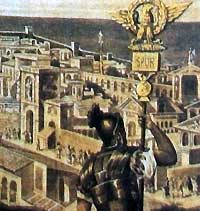Valentia - the Roman Origins
138 BC to 304 AD
 Although
the area was originally populated by the Iberian tribes, there actually
was no Iberian settlement in this place. Valentia was founded in 138 BC
by Roman legionnaires from Campania, Southern Italy, who were given lands
in newly conquered territories as a reward for their service. Although
the area was originally populated by the Iberian tribes, there actually
was no Iberian settlement in this place. Valentia was founded in 138 BC
by Roman legionnaires from Campania, Southern Italy, who were given lands
in newly conquered territories as a reward for their service.
Although "Valentia" means vigor, it was only a fashion of the
times to display military might in city names. Valentia was not meant
as a fort, rather it was a retirement buisness for the soldiers. The city
instantly became a lively economic player.
However, in 75 BC the Roman Republic sparked off a number of civil wars
and Valentia was almost entirely raised to the ground by Pompeus. It remained
a ghost town for 50 years or so.
At the turn of the millenium a new influx of Roman colonists re-populated
Valentia and it began a sharp ascent towards its apogee in 1st and 2nd
centuries AD.
Although it was only a fraction of what is
now the city centre, Valentia was a truly blossoming city of its times.
The central forum with the administrative and religious structures was
surrounded by a strict geometrical grid of villas of the nobility. The
city was covered in richly painted marble and surrounded by a wall. There
was everything that a city of those times was meant to have, including
a 300m x 75m arena for chariot racing, that could accommodate 10000 people.
The population kept booming due to the constant trickle of new settlers
(in the process creating two major "political parties" in the
Valencian Senate - "The Veterans" and "The Old") and
so did the economy.
However, the decadence of the Roman Empire in the 3rd century AD led
to a decline in prosperity of Valentia.
Sights from the period:
Almoina | Crypt
of San Vicente Martir
Map: Location of Roman
Valencia
|